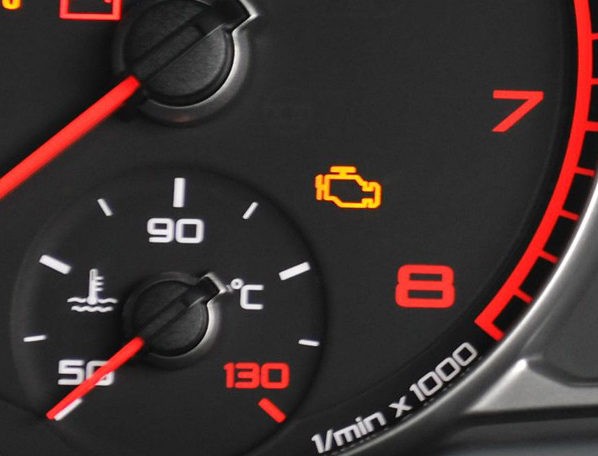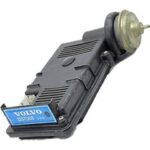As an expert at OBD-DE, specializing in automotive diagnostics and repair, I understand the concern that arises when an unfamiliar light illuminates on your dashboard. Among these, the engine management light, often appearing as an orange or amber engine symbol, is a common cause for worry. This guide will thoroughly explain what an orange engine light signifies, what actions you should take, and how to address the underlying issues.
Understanding the Engine Management Light (EML)
The engine management light (EML), also frequently referred to as the ‘check engine light’, is a crucial component of your vehicle’s onboard diagnostic system. It’s designed to alert you to potential malfunctions within your car’s engine, exhaust system, or emission control systems. Unlike specific warning lights that pinpoint issues like low oil level, the EML is a general indicator signaling that something is amiss and requires attention.
Modern vehicles are equipped with sophisticated sensor networks that constantly monitor the performance of various systems. These sensors track parameters such as air intake, exhaust emissions, fuel combustion efficiency, and numerous other engine operations. This data is processed by the car’s computer, ensuring optimal performance and adherence to emission standards.
Most of the time, these sensors operate without incident. However, when a deviation from the norm occurs, whether minor or significant, the EML illuminates to inform the driver. The engine management light is universally recognized by its engine-shaped icon. Critically, the color of the EML—orange, flashing orange, or red—indicates the severity of the problem.
Decoding the Orange Engine Management Light
An orange engine management light is generally the least severe of the warnings. When this light appears and remains steadily lit, it indicates a problem that needs addressing but is typically not an emergency requiring you to stop immediately. It signals that your vehicle’s system has detected an issue that is affecting engine performance or emissions, but not critically enough to cause immediate damage.
What to do when the orange engine light is on:
- Don’t Panic: An orange light is a signal to investigate, not necessarily a sign of imminent engine failure.
- Continue Driving (Cautiously): In most cases, you can continue driving, but it’s advisable to do so with caution. Avoid heavy acceleration or high speeds if you notice any changes in your vehicle’s performance.
- Schedule a Diagnostic Check: It’s crucial to get your vehicle checked by a qualified mechanic as soon as possible. Delaying a check-up can lead to more significant problems and potentially more costly repairs down the line.
Other Engine Management Light Signals: Flashing Orange and Red
While an orange light is a moderate warning, it’s important to differentiate it from other EML signals:
-
Flashing Orange Engine Light: A flashing orange light indicates a more serious issue than a steady orange light. It often suggests a problem that is actively affecting engine operation, such as an engine misfire. You might notice symptoms like engine shaking, rough idling, or unusual noises. A flashing orange light requires immediate attention. You should reduce speed, drive cautiously to the nearest safe location or repair shop, and seek professional help promptly.
-
Red Engine Management Light: A red engine management light signifies a critical problem that could cause severe engine damage. If you see a red EML, you should stop your vehicle in a safe location as soon as possible and turn off the engine. Contact roadside assistance or a professional mechanic immediately. Driving with a red engine light is risky and could lead to extensive damage and unsafe driving conditions.
Common Causes of an Orange Engine Light
Numerous issues can trigger an orange engine management light. Here are some of the most frequent culprits:
-
Oxygen Sensors or Mass Airflow (MAF) Sensor Issues:
- Oxygen Sensors: These sensors monitor the amount of oxygen in the exhaust gases. Incorrect readings can indicate an improper fuel-air mixture (too rich or too lean), triggering the orange light.
- Mass Airflow (MAF) Sensor: The MAF sensor measures the volume of air entering the engine, crucial for calculating the correct fuel delivery. A faulty or dirty MAF sensor can disrupt the fuel-air mixture, leading to an EML.
-
Ignition System Problems:
- Spark Plugs: In gasoline engines, worn or fouled spark plugs can cause misfires, leading to unburnt fuel entering the exhaust system and triggering the orange light.
- Ignition Coils: These components provide the high-voltage spark needed for ignition. Failing ignition coils can cause misfires, similar to spark plug issues.
-
Loose or Faulty Fuel Cap:
- A seemingly minor issue like a loose or damaged fuel cap can cause fuel vapor leaks. The evaporative emission control system (EVAP) is designed to prevent fuel vapors from escaping into the atmosphere. A loose cap can disrupt this system, setting off the orange engine light.
-
Catalytic Converter Problems:
- The catalytic converter reduces harmful pollutants in exhaust gases. Damage or inefficiency, often due to engine problems like misfires or oil leaks, can cause it to malfunction and activate the EML. Catalytic converter issues are serious as they affect both vehicle performance and environmental impact.
-
Exhaust Leaks:
- Leaks in the exhaust system can alter pressure and sensor readings, leading to an orange engine light. Leaks can occur in various parts of the exhaust system, from manifolds to pipes and mufflers.
-
EGR Valve Issues:
- The Exhaust Gas Recirculation (EGR) valve recirculates a portion of exhaust gas back into the engine intake to lower combustion temperatures and reduce NOx emissions. A malfunctioning EGR valve can affect engine performance and trigger the EML.
-
PCV Valve Problems:
- The Positive Crankcase Ventilation (PCV) valve manages engine crankcase gases. A faulty PCV valve can cause vacuum leaks or pressure imbalances, leading to engine issues and an orange light.
-
Vacuum Leaks:
- Vacuum leaks in intake manifolds or vacuum lines can disrupt the engine’s air-fuel mixture and overall operation, often resulting in an orange engine light.
Diagnosing the Orange Engine Light: Using OBD-II Scanners
To accurately determine why your orange engine light is on, a diagnostic scan is necessary. Modern vehicles use an On-Board Diagnostics II (OBD-II) system, which provides error codes that pinpoint the source of the problem.
How to diagnose:
- Use an OBD-II Scanner: An OBD-II scanner is a tool that plugs into your car’s diagnostic port (usually located under the dashboard). This scanner reads the diagnostic trouble codes (DTCs) stored by your car’s computer.
- Interpret the Error Codes: The OBD-II scanner will display codes that correspond to specific issues. For example, codes starting with ‘P0’ typically relate to powertrain issues (engine and transmission).
- Professional Diagnosis: While you can read the codes yourself, interpreting them and accurately diagnosing the root cause often requires professional expertise. Mechanics at certified repair shops or service centers are equipped to perform comprehensive diagnostics.
At OBD-DE, we advocate for using reliable OBD-II tools for accurate diagnostics. Understanding these codes can save time and money by directing repairs effectively.
Can You Drive with an Orange Engine Light On?
Generally, yes, you can drive with a steady orange engine light, but it’s not recommended for extended periods. Think of it as a yellow traffic light—proceed with caution.
Consider these points:
- Potential for Damage: Ignoring an orange light can lead to more severe damage over time. Minor issues can escalate into major repairs if left unaddressed.
- Reduced Fuel Efficiency: Engine problems indicated by the orange light often affect fuel economy.
- Emissions Issues: Many orange engine light triggers are related to emission control systems. Driving with the light on might mean your car is emitting higher levels of pollutants.
- Performance Issues: You might experience subtle performance reductions that worsen over time if the underlying problem is not fixed.
When to avoid driving:
- Flashing Orange or Red Light: Never drive with a flashing orange or red engine light unless it’s to move the car to a safe spot or to a nearby repair facility at very low speed. These signals indicate severe issues that can cause immediate damage.
- Noticeable Symptoms: If the orange light is accompanied by significant symptoms like loud noises, smoke, loss of power, or rough engine operation, it’s best to stop driving and seek immediate assistance.
Resetting the Engine Management Light
Sometimes, after addressing a minor issue like tightening a fuel cap, the orange engine light might remain on. Modern car computers are designed to keep the light illuminated for a certain number of drive cycles to ensure the problem is truly resolved.
Methods to reset (with caution):
- Automatic Reset: In some cases, the light will turn off automatically after a few drive cycles if the problem is resolved and the system re-confirms normal operation.
- OBD-II Scanner Reset: Most OBD-II scanners have a function to clear diagnostic trouble codes and reset the engine light. However, only use this function after you have diagnosed and addressed the underlying issue. Resetting the light without fixing the problem will only hide the symptom temporarily, and the light will likely reappear.
- Battery Disconnect (Use with Caution): Disconnecting the negative battery terminal for about 15-30 minutes can sometimes reset the car’s computer and clear the engine light. However, this method is not recommended as it can also reset other vehicle systems, such as radio presets and security systems, and might not effectively resolve the underlying issue.
Important Note: Resetting the engine light without proper diagnosis and repair is not a solution. It’s crucial to identify and fix the root cause of the problem. If the light comes back on, it confirms that the issue persists.
Orange Engine Light and MOT/Vehicle Inspections
In many regions, including the UK and Europe, a lit engine management light is an automatic failure during a mandatory vehicle inspection (like the MOT in the UK). If the light is on during the test, the vehicle will fail because it indicates a problem that could affect safety or emissions.
Prepare for inspection:
- Address the Light Beforehand: If your car is due for inspection, ensure any engine management lights are resolved before the test.
- Professional Check: Have a mechanic diagnose and repair the issue, and verify that the light is off before taking your car for inspection.
Conclusion: Take Action When You See an Orange Engine Light
The orange engine management light is an important indicator of potential problems in your vehicle’s engine or related systems. While it’s generally less urgent than a flashing orange or red light, it should never be ignored. Prompt diagnosis and repair are essential to prevent further damage, maintain fuel efficiency, ensure emission compliance, and guarantee your vehicle’s reliability and safety.
As your automotive experts at OBD-DE, we recommend acting responsibly when you see an orange engine light. Use this guide to understand the possible causes, consider using an OBD-II scanner for initial diagnostics, and consult with a professional mechanic for accurate diagnosis and repair. Taking timely action will keep your vehicle running smoothly and avoid costly future repairs.

